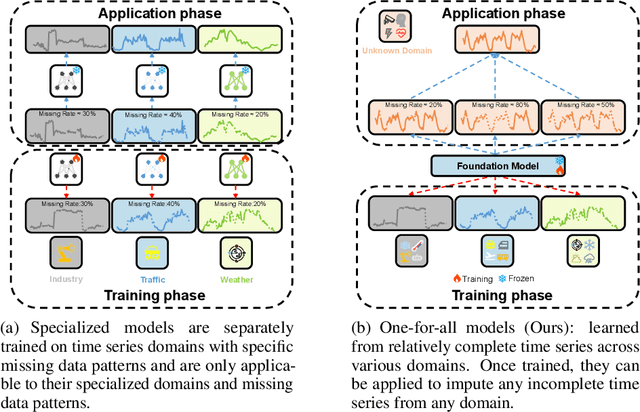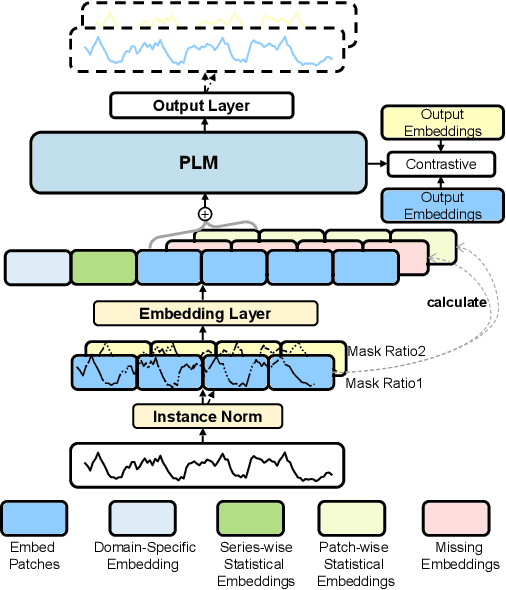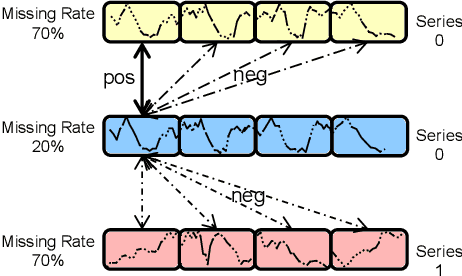Jinguo Cheng
NuwaTS: a Foundation Model Mending Every Incomplete Time Series
May 27, 2024



Abstract:Time series imputation plays a crucial role in various real-world systems and has been extensively explored. Models for time series imputation often require specialization, necessitating distinct designs for different domains and missing patterns. In this study, we introduce NuwaTS, a framework to repurpose Pre-trained Language Model (PLM) for general time series imputation. Once trained, this model can be applied to imputation tasks on incomplete time series from any domain with any missing patterns. We begin by devising specific embeddings for each sub-series patch of the incomplete time series. These embeddings encapsulate information about the patch itself, the missing data patterns within the patch, and the patch's statistical characteristics. To enhance the model's adaptability to different missing patterns, we propose a contrastive learning approach to make representations of the same patch more similar across different missing patterns. By combining this contrastive loss with the missing data imputation task, we train PLMs to obtain a one-for-all imputation model. Furthermore, we utilize a plug-and-play layer-wise fine-tuning approach to train domain-specific models. Experimental results demonstrate that leveraging a dataset of over seventeen million time series from diverse domains, we obtain a one-for-all imputation model which outperforms existing domain-specific models across various datasets and missing patterns. Additionally, we find that NuwaTS can be generalized to other time series tasks such as forecasting. Our codes are available at https://github.com/Chengyui/NuwaTS.
Rethinking Urban Mobility Prediction: A Super-Multivariate Time Series Forecasting Approach
Dec 04, 2023Abstract:Long-term urban mobility predictions play a crucial role in the effective management of urban facilities and services. Conventionally, urban mobility data has been structured as spatiotemporal videos, treating longitude and latitude grids as fundamental pixels. Consequently, video prediction methods, relying on Convolutional Neural Networks (CNNs) and Vision Transformers (ViTs), have been instrumental in this domain. In our research, we introduce a fresh perspective on urban mobility prediction. Instead of oversimplifying urban mobility data as traditional video data, we regard it as a complex multivariate time series. This perspective involves treating the time-varying values of each grid in each channel as individual time series, necessitating a thorough examination of temporal dynamics, cross-variable correlations, and frequency-domain insights for precise and reliable predictions. To address this challenge, we present the Super-Multivariate Urban Mobility Transformer (SUMformer), which utilizes a specially designed attention mechanism to calculate temporal and cross-variable correlations and reduce computational costs stemming from a large number of time series. SUMformer also employs low-frequency filters to extract essential information for long-term predictions. Furthermore, SUMformer is structured with a temporal patch merge mechanism, forming a hierarchical framework that enables the capture of multi-scale correlations. Consequently, it excels in urban mobility pattern modeling and long-term prediction, outperforming current state-of-the-art methods across three real-world datasets.
 Add to Chrome
Add to Chrome Add to Firefox
Add to Firefox Add to Edge
Add to Edge